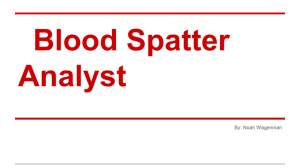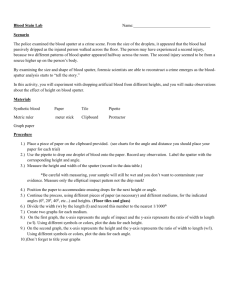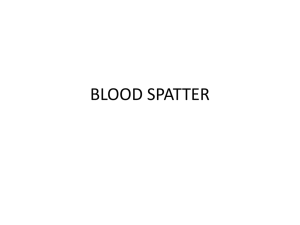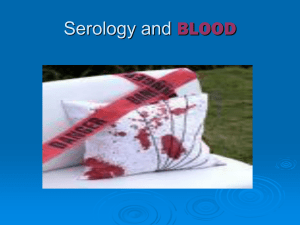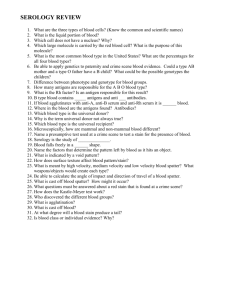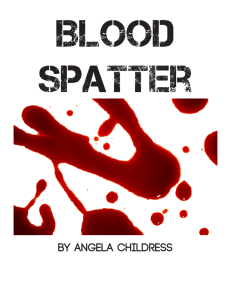see earlier slide
advertisement
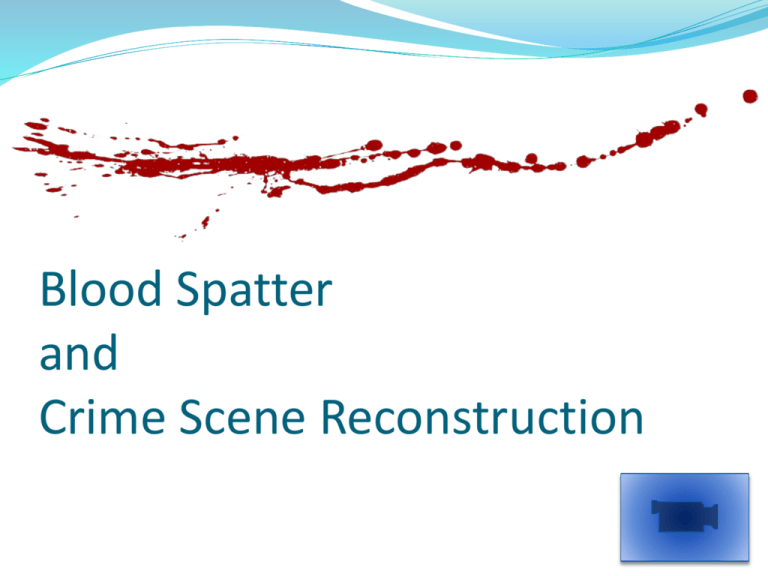
Blood Spatter and Crime Scene Reconstruction What is blood? Blood Typing: Class Data Sample Blood Group Frequencies Interlude The Real CSI First Determine: Is it Blood? Kastle-Meyer Test Blue Star® Luminol Leucomalachite Is it Human? ELISA (enzyme linked immunosorbent Assay What Blood pattern analysis reveals Origin of the bloodstain Distance between blood source and target Direction of travel and impact angles of droplets Type of force used to cause bloodshed Type of object used Sequence of multiple bloodshed events Contact and transfer patterns Blood Spatter Blood Spatter Overview andforce Criminal Activity PatternsDependence produced when is applied to blood Types / Classification Methods of Identification Physical properties of blood Collection and Preservation of Evidence Blood is a fluid droplets round up in air flattened contacting surfaces 2 Main Types of Blood Patterns Spatter Patterns–impact pattern of blood droplets Why spatter looks the way it does Slomo spatter Transfer Patterns–from one surface to another Droplet Size and Shape Size (0.3 – 0.5 mm diameter) Distance traveled Texture of surface Direction Traveled Angle of impact Origin of Impact Velocity (Low, Medium, High) Texture of Surface Smooth surface (glass, marble) Circular Uniform Porous surface irregular shape spikes and satellites Spike Satellite Direction of Spatter Low impact spatter 90o impact angle no tail Higher impact spatter tail points in direction of travel Angle of Impact The larger the angle of impact, the longer the tail Convergence Point (2D) and Origin of Impact (3D) Convergence Crime Scene exercise Determining Angle of Impact Determining the angle of impact: measure width (W), length (L) Solve: 𝜃 = 𝑊 −1 𝑠𝑖𝑛 𝐿 Point of Origin (3D) Spatter Patterns Impact pattern of blood droplets function of speed and energy of droplets 3 main types: high velocity medium velocity low velocity High Velocity Spatter Patterns Droplet size < 2mm diameter – “mist like” Impact force > 100 ft/sec Gunshots, explosions and high speed collisions Short travel distance High Velocity Gun Shot Spatter Back spatter - toward gun forward spatter - in bullet direction Amount of spatter Caliber of bullet larger bullet, more spatter Distance closer, more spatter Why back spatter? Medium Velocity Spatter Patterns Droplet size: 2mm – 4mm diameter Impact force > 25 ft/sec Blunt force, stabbing and secondary spatter Low Velocity Spatter Patterns Droplet size: > 4mm diameter Large, circular shape Velocity due to gravity open wounds, saturated surfaces increase size with distance (see earlier slide) Cast Off Spatter Patterns Blood covered object flings blood into the air handedness number of blows direction of impact amount of blood Contact Patterns a wet bloody surface contacts another surface Types of transfer: Transfer - a recognizable image is formed Swipes - wet blood is transferred to a surface wipes - “clean” object moves through blood Other Spatter Patterns Arterial Spray Spatter Expirated Blood Spatter Voids Documenting Blood Patterns Evidence Overview Photo - each pattern Note, sketch and photograph droplets used to do point of origin calculations droplet samples sent to lab for analysis
